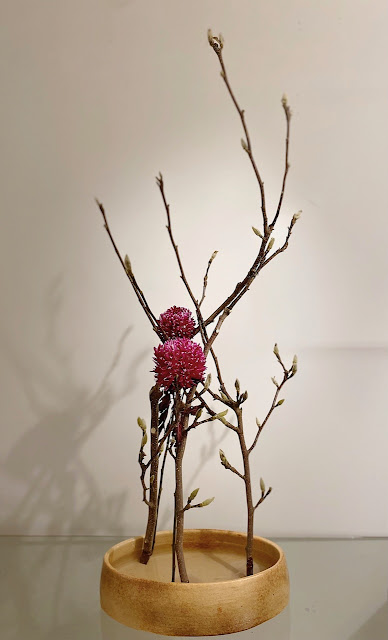In Melbourne, away from Torquay's salt air and strong prevailing westerly winds, northern hemisphere plants have a better chance of flourishing.
I took this photo a few weeks ago of Japanese Ivy Parthenocissus tricuspidata, on a garden wall in South Yarra. The richness of the red and two contrasting leaves with some residual green colouring really caught my attention.
However, by the coast we are fortunate to have the much tougher Australian native flora with its often unusual forms in the flowers and seed-heads. This particular plant, Bushy Yate Eucalyptus lehmannii is endemic to the south-west of Western Australia. One of the beautiful phases of its flower development is the colour change from green to orange of the operculum before they fall of and reveal the green stamens of the flowers.
As I was taking the first photo Laurie pointed out to me the New Holland Honeyeater just below the opened flower. The black and grey feathers of the bird make it hard to see, apart from the yellow flash on its wing.
At a recent class in Geelong I set the senior students the exercise of making an ikebana using "One material only", in a nageire vessel.
Jo's exercise was to make a "Minature ikebana". This is not quite as it sounds. The exercise is to encourge the ikebanist to look very closely at the elements of which plants are made. Having done so, they are then required to harmoniously arrange the elements by placing them in a variety of very small vessels. This work really is difficult to photograph and is best appreciated by close inspection.
My own ikebana is the fourth photo from my demonstration for the Geelong Gallery in conjunction with the current "Cutting Through Time" Exhibition.
I came across a large piece of Eucalyptus bark, with a beautiful rich red-ochre coloured underside, while walking along the creek path. Because of its size, I chose a largish bowl-shaped vessel by Isabella Wang. The full width of the bark is just over one metre. As the bark is dry and does not need water I have arranged it so that is "floating" above the vessel. Three Coastal Banksia, B. integrifolia, leaves and flowers from the garden have been added, giving fresh life to the ikebana. The harmony with the wall behind is purely coincidental.
Greetings from Christopher
9th June 2024
9th June 2024










No comments:
Post a Comment